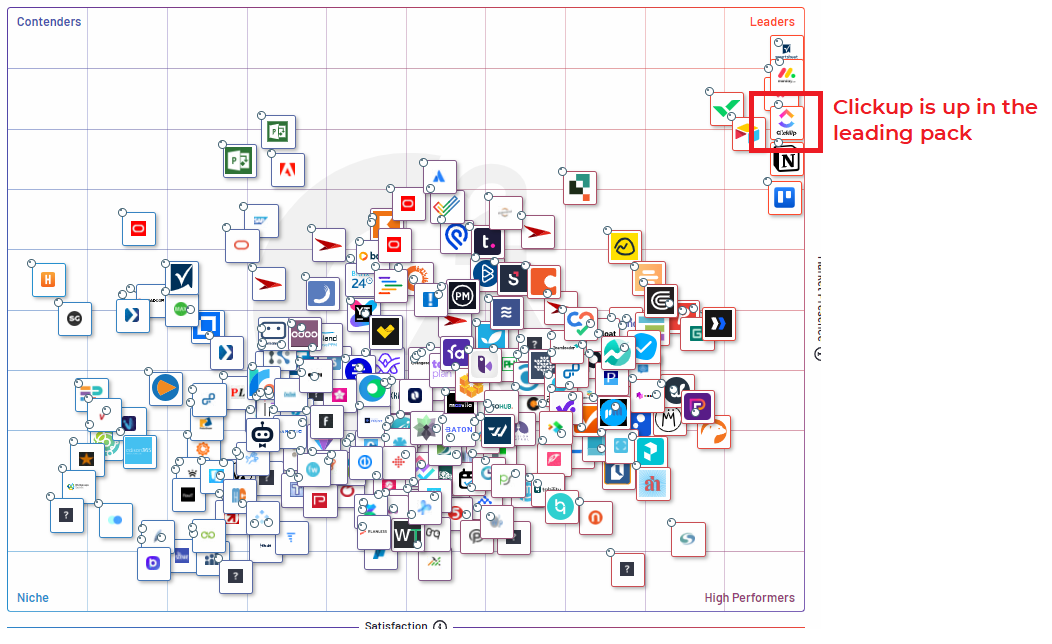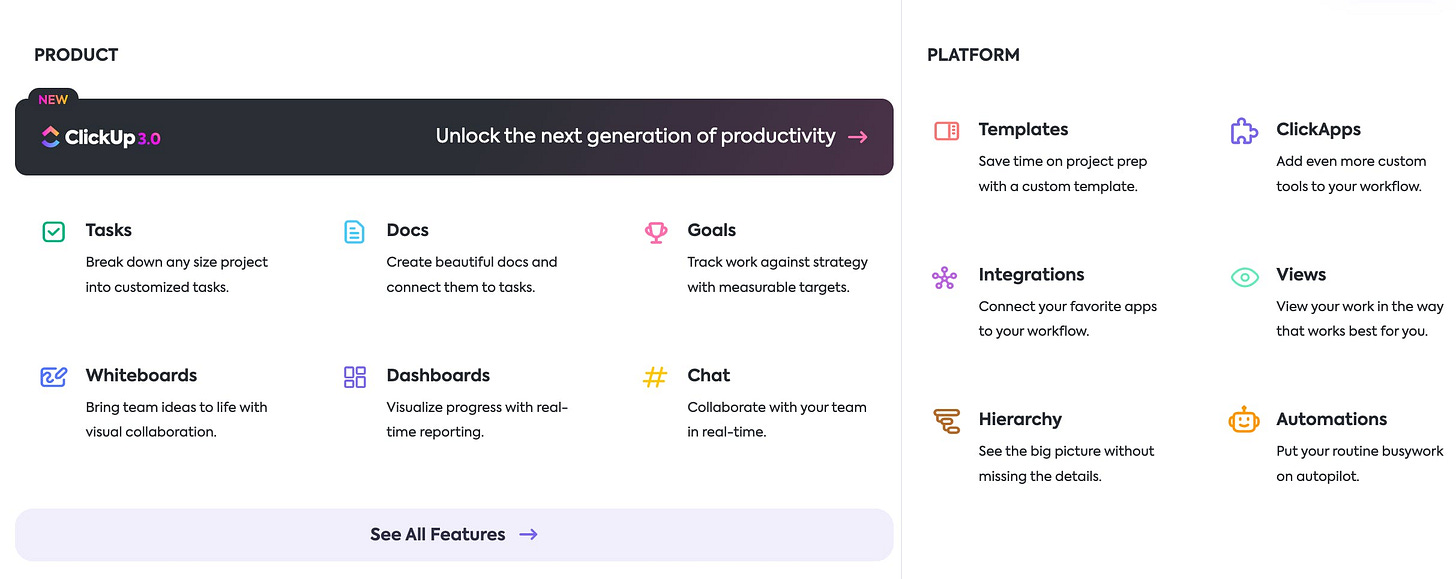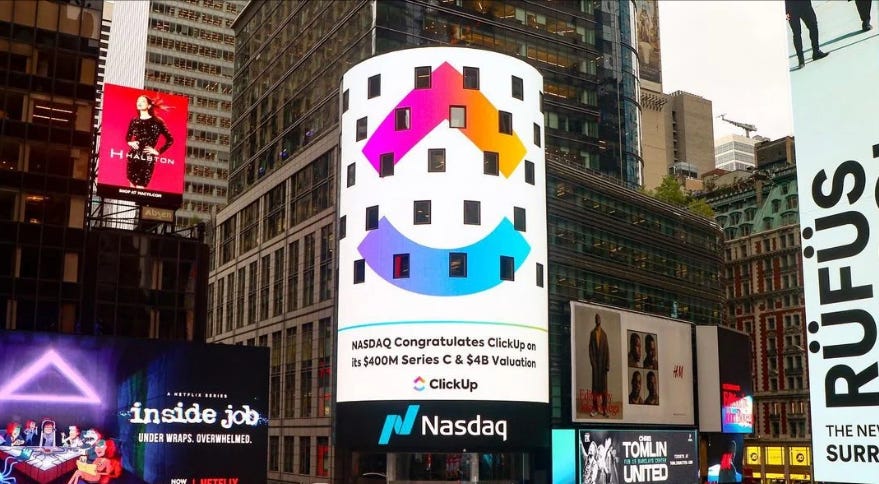How did Clickup become a $150M revenue machine?
+ lessons for product managers and marketers from their journey
Hey BPL fam,
In this edition of Behind Product Lines, we’re going to dive deep into a product and marketing case study.
We’ll be looking into Clickup - a project management and productivity tool for individuals and teams of all sizes.
What makes their story different from others?
Well, despite being a late entrant into the market by several years, Clickup navigated through the notoriously crowded project management tool space and gave top players like Monday and Asana a run for their money.
What’s even more impressive is that they bootstrapped their way to $20M ARR before taking on funding. And while most of their post-PMF strategies required healthy amounts of cash, one simply cannot convince 85,000 customers to pay up without having a product that’s worth its salt. Money can only get you so far.
The stats are quite compelling:
0 to $20 Million in the first 2 years
Current Revenue > $150M ARR
Customers > 85K
Valuation = $4 Billion
”Hey, what about profits?”
When I posted this story on my LinkedIn feed, Jason Fried (CEO of 37signals, creator of Basecamp) prompted the same question. Interestingly, Zeb Evans chimed in to assure that they were on course to become green again.
Moreover, third-party review sites also confirm that Clickup soon became a preferred provider for many. It’s not easy to cut through the red ocean of provider logos on G2 and end up on the top-right of their performance matrix:
The rather eccentric part of Clickup’s story is that their strategy and tactics seem to throw “caution to the wind”. They tend to be counter-intuitive and at a tangent to conventional wisdom.
While I invite readers to understand the mechanics behind their success, I request readers to exercise discretion and not just copy their playbook.
Let’s dive in.
For those reading this in their email inbox
This post is a bit too long for email. To catch the full story, visit Behind Product Lines.
Backstory
Clickup was launched in 2017 and was founded by Zeb Evans and Alex Yurkowski.
Evans, in particular, had an entrepreneurial history having founded a social media automation tool called “Fast Followerz” which he later sold.
In 2015, he started working on a new startup called Mimri - a social media platform - where he joined hands with Yurkowski. During this tenure, they used several productivity tools but none were comprehensive enough to do their job. They eventually decided to build a custom in-house solution.
They shared their solution outside the company as well and it started getting some buzz. Soon, they realized that their project management tool had far more potential than Mimri and thus, decided to pivot.
As seen in several startups, founders start by solving a problem they face themselves. When you’re using the product day in and day out, you’re also getting instant feedback and validation from your team.
Unpacking Clickup’s product & growth strategy
1) The Secret Sauce: The Flywheel
Zeb shared a "flywheel" that encapsulates their unique approach to organic growth and user-centricity. He claims that it was how they were able to scale so quickly.
It starts with constantly absorbing feedback from users and combining that with high delivery velocity.
But does this imply creating a feature factory? IMHO while Clickup kept the “opinion doors” open, they were judicious in picking their battles. They converted those insights into decisions quickly. Moreover, the project management space was so mature, that they were naturally going to have to play catch up in the beginning and greenlight a lot of initiatives.
2) Established strong feedback loops
Zeb and his team were not just open to feedback; they were actively seeking it out. Employing platforms like Canny, conducting quick daily surveys, and engaging in Zoom interviews and in-person chats, they made feedback collection an everyday ritual.
2) Shipped with rigor
Clickup was bullish on its counter-intuitive development principles:
Ship every Friday without fail.
Progress is more critical than perfection. Ship & then learn.
Know that users, especially early adopters, are forgiving of minor issues.
Keep HTML & JS teams separate to keep velocity high.
Opt for 5x engineers you can coach and up-skill instead of 10x (expensive) talent found in Google, Meta, or Amazon.
Set aside tech debt in the initial days to maintain velocity.
Many people asked me about the HTML & JS team points. In Zeb’s own words:
People programming in Javascript should not be writing HTML and CSS.
They shouldn’t be making your product pixel-perfect. This little change will make everyone on your team happy. It’s a win-win for your engineers and will save you lots of time.
3) Targeted an ambitious scope
Clickup didn’t waste time in attacking different project management modules. It started as a platform with Task management but then quickly expanded into Goals, Whiteboards, Chat, and Dashboards.
This seems counter-intuitive. Usually, product teams are advised to focus on a problem or theme in the early days and iterate.
Of course, Clickup’s strategy makes more sense when you consider how mainstream their product category already was.
4) Fuel conversions via Content Marketing
Here are a few tactics they deployed:
(a) Launched comparison pages for their peer set.
They attacked high-traffic but low-to-medium competition keywords that had comparison intent like “best project management software”. Remember: back then, the SERPs for these keywords were dominated by third-party review sites like G2, Capterra, and so on because they covered reviews of multiple tools.
Clickup was one of the few providers that directly referenced competitors and wrote comprehensive SEO-conducive blogs and battle card pages to get ahead in rankings.
They made it easy for people to visualize how Clickup fared against their competitors:
(b) Aggressive SEO for top/long-tail KWs
Posting a daily blog, they managed to generate an astounding $12M worth of free clicks.
Their themes attacked all parts of the funnel:
Top-of-funnel: addressing high-level customer problems like team meetings
Middle-of-funnel: round-up posts about the best project management tools
Bottom-of-funnel: promoting Clickup templates to improve productivity.
(c) Focused on Community Engagement
Once Clickup brought on a community manager to their team, they unleashed a flurry of personalized content on Quora and Reddit, further fueling their organic reach. She chose to answer a wide range of questions.
4) Fused Product-led growth with Enterprise Sales
(a) ClickUp not only offers a freemium model but also highly affordable paid tiers.
The $5 plan is pretty compelling for small teams.
But it’s important they attacked both ends of the candle.
Once they attained sufficient scale, they combined their bottom-up product-led strategy with a top-down enterprise motion to amplify their revenue generation cycle. This allowed them to capture the loyalties of entire organizations like Netflix and Logitech.
But this begs a question.
How did they convince teams who were already on Asana, Trello, and Monday to switch?
Well, the biggest adoption barrier was customers of competitors already had tons of data on their respective instances.
Clickup addressed this by baking in an intuitive task import tool in their onboarding experience. This helped put people at ease and allowed them to ensure business continuity.
Understanding the PLG mechanics well, Clickup not only prioritized a great onboarding experience, they actually incentivized it.
The team was convinced that great onboarding led to better retention. This ensured customers didn’t go back to competitive products. They were so bullish on this that they offered credits to people who skipped the onboarding video to go back & watch it.
Moreover, Clickup shortened the time-to-value by crafting specific user paths for each persona and presenting them with preloaded templates for their use case. This invoked the aha moment early in their usage.
5) Leveraged network effects & referrals
(a) Collaboration was in Clickup's product DNA. An individual using Clickup would invite their entire team to the workspace catalyzing growth.
(b) Clickup also incentivized users to refer others in exchange for Clickup credits.
(c) Finally, they established an affiliate program to get blogs & web pages to promote their brand in exchange for commissions.
6) Executed some purple cow marketing
Clickup needed to stand out in the crowded market to catch attention. They needed to stir the pot, so to speak.
It experimented with a humorous brand voice which didn't always stick to the landing but was memorable, to say the least. What’s interesting is how they clearly called out their target personas in their videos making it crystal clear who they were speaking to.
Ran edgy performance ads
Clickup used unconventional skits to show how they eased lives. But they didn’t hold back. They called out JIRA in one particular ad campaign.
Yes, they kind of roasted them.
Outdoor advertising
Post VC funding, Clickup's Chief Creative Officer (who used to work at Cheddar) ran outdoor billboards to amplify awareness e.g. subways, streets, buses, etc. This spread the word wide and far.
Other tactics Clickup is using to continue its growth
ClickUp 3.0: It’s been creating excitement among users by launching a waitlist for a new version of Clickup that’s highly anticipated to have features like universal search and custom task types.
ClickUp AI: Like many others, they are jumping into the Generative AI bandwagon by helping users generate tasks and automation quickly.
ClickUp University: By offering courses and certifications, they enable users to learn how to extract the maximum juice from their platform. But more importantly, they are effectively locking them into an ecosystem.
Affiliate and Partner Programs: They now work with partners and incentivize affiliates to recommend them to their audiences. This keeps their acquisition wheels turning.
Global Expansion: Finally, Clickup is slowly targeting emerging markets in Asia, Africa, and South America to diversify revenue streams and increase market share.
In summary, here are the pillars that powered Clickup’s growth:
1) Established strong feedback loops with customers. Understand their pain points and bake nifty solutions back into the product.
2) Shipped with rigor and velocity. Customers only see what they get in their hands. Clickup ensures they are consistently delivering value. This is a tricky one though as it’s very easy to mix this with a feature factory.
3) Acquired organic users via compelling content. Acquisition can be done through paid means but the cheapest, most resilient form of growth is through hardcore SEO. Clickup succeeded in channeling free traffic without having to pay hefty ads at the start.
4) Used PLG models with stellar onboarding and combined it with enterprise sales. I’ve seen many PMs think PLG is the only way to sustainable growth. However, the answer is more nuanced. You need both PLG and enterprise sales motions to generate serious compounding growth. Of course, the timing for each is crucial.
5) Leveraged network effects & referrals. Their referral system paired with a slick migration experience offered another potent acquisition channel.
6) Opted for purple cow marketing to stand out. Product marketers may feel safe sticking to traditional marketing tactics but the upside is relatively incremental. Clickup realized they had to shake things up so they took a left-field bold approach. Some of their risks paid off, some didn’t - but they had created the dent they were hoping for.
Hope that was helpful.
Till next time,
Aatir


















Great read! A reminder that customer obsession is key 🔑
Incredible post, thank you for sharing.
I love success stories. I would have loved to see the size of the team when they first started properly shipping. That kind of velocity is insane; and making the conscious decision to set debt aside is also surprising (although I guess all startups do that by default, to some extent).
They’ve nailed their marketing. I don’t use them, but I know of them. A while back they also had a pricing plan ‘pay what you can’ type thing, which I thought was genius.